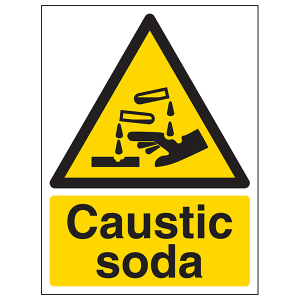Caustic Soda Dangerous

General Description of Caustic Soda Dangerous
Persons whose clothing or skin is contaminated with solid sodium hydroxide or its solutions can secondarily contaminate rescuers by direct contact.
Sodium hydrate (Soda Lye) is a white, noncombustible solid that absorbs moisture from the air. When the solid is in contact with water, it may generate sufficient heat to ignite combustible materials. The solid and its solutions are corrosive. Sodium hydroxide is odorless; thus, odor provides no warning of hazardous concentrations.
Caustic Soda does not produce systemic toxicity, but is very CORROSIVE and can cause severe burns in all tissues that it comes in contact with. Sodium hydroxide poses a particular threat to the eyes, since it can hydrolyze protein, leading to severe eye damage.
Routs of Exposure with Caustic Soda Dangerous
Inhalation
Inhalation of sodium hydroxide dust, mist, or aerosol may cause irritation of the mucous membranes of the nose, throat, and respiratory tract. Sodium hydroxide is odorless; thus, odor provides no warning of hazardous concentrations. Mucous membrane irritation occurs at the OSHA PEL (2 mg/m3) and is generally an adequate warning property for acute exposure to sodium hydroxide. However, workers exposed to prolonged or recurrent mists or aerosols of sodium hydroxide can become somewhat tolerant of the irritant effects. Sodium hydroxide of sufficient strength can hydrolyze proteins in tissues and can kill cells in tissues.
Children exposed to the same levels of sodium hydroxide in air as adults may receive a larger dose because they have greater lung surface area: body weight ratios and increased minute volumes: weight ratios. In addition, they may be exposed to higher levels than adults in the same location because of their short stature and the higher levels of sodium hydroxide in air found nearer to the ground.
Skin/Eye Contact
Exposure to sodium hydroxide solid or solution can cause skin and eye irritation. Direct contact with the solid or with concentrated solutions causes thermal and chemical burns leading to deep-tissue injuries.
Very strong solutions of sodium hydroxide can hydrolyze proteins in the eyes, leading to severe burns and eye damage or, in extreme cases, blindness.
Children are more vulnerable to toxicants affecting the skin because of their relatively larger surface area: body weight ratio.
Ingestion
Ingestion of sodium hydroxide can cause severe corrosive injury to the lips, tongue, oral mucosa, esophagus, and stomach.

